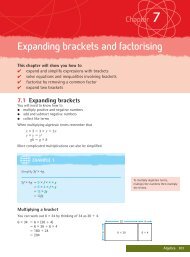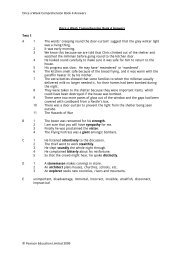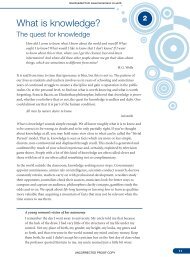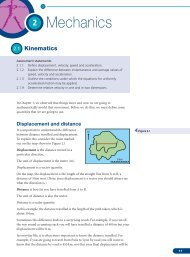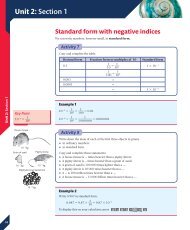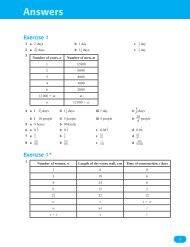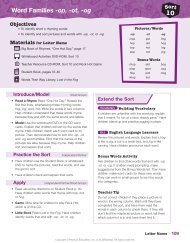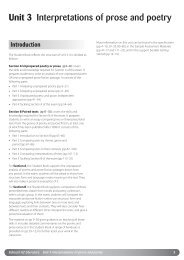Chapter 1: Hardware - Pearson Schools
Chapter 1: Hardware - Pearson Schools
Chapter 1: Hardware - Pearson Schools
Create successful ePaper yourself
Turn your PDF publications into a flip-book with our unique Google optimized e-Paper software.
The main remote control technology used in the home is infrared. The signals<br />
between a remote control handset and the device it is controlling are infrared light<br />
pulses, which are invisible to the human eye.<br />
The transmitter in the remote control handset sends out a pulse of infrared light<br />
when a button is pressed on the handset. A transmitter is often a light-emitting<br />
diode (LED) which is built into the pointing end of the remote control handset (see<br />
Figure 1.25). The infrared light pulse represents a binary code that corresponds to<br />
a command, such as ‘power on’ or ‘volume down’. A receiver is built into the<br />
device being controlled in a position where it can easily receive the infrared light<br />
pulses – for example, it is built into the front of a satellite TV receiver. The receiver<br />
passes the code to a microprocessor, which decodes it and carries out the<br />
command.<br />
The remote control handset will often have two LEDs that light up at the same time<br />
when a button is pressed. One LED is the infrared transmitter and the light from<br />
this is invisible. The other LED emits a visible light and this is to reassure the user<br />
that the remote control is functioning (see Figure 1.25).<br />
Some handsets only work when they are pointing directly at the receiver on the<br />
controlled device, while others work when they are pointing generally towards the<br />
receiver. This is because the strength of the infrared light pulse varies. A handset<br />
with more than one infrared LED or a very powerful LED can produce a stronger,<br />
broader signal.<br />
Advantages of remote control:<br />
<br />
<br />
Less movement and energy are needed to operate remote controlled devices.<br />
Inaccessible or hidden devices can be controlled.<br />
Figure 1.24 A remote control handset<br />
<strong>Chapter</strong> 1: <strong>Hardware</strong><br />
Disadvantages of remote control:<br />
<br />
Some devices cannot be operated without the remote control handset. If this is<br />
lost or damaged, the device cannot be used.<br />
Output devices<br />
Monitors<br />
Monitors are also known as visual display units (VDUs). They come in different<br />
styles and quality levels. Screen colour quality, resolution and clarity are just some<br />
of the features that affect how desirable a particular monitor is to you.<br />
Picture elements<br />
Although the picture on a computer monitor may look sharp and clear, it is made<br />
up of many illuminated dots known as picture elements or pixels. The dots are<br />
usually so tiny that you would not normally notice them individually – you just see<br />
the whole picture. If you could actually see the picture elements, the picture would<br />
look jagged (see Figure 1.26).<br />
The screen itself may perhaps have 1024 screen dots going across the screen, and<br />
768 from top to bottom. In this case the screen is said to have a resolution of<br />
Figure 1.25 The LEDs built into a remote control<br />
handset<br />
15








